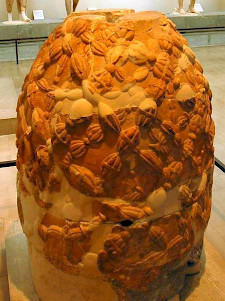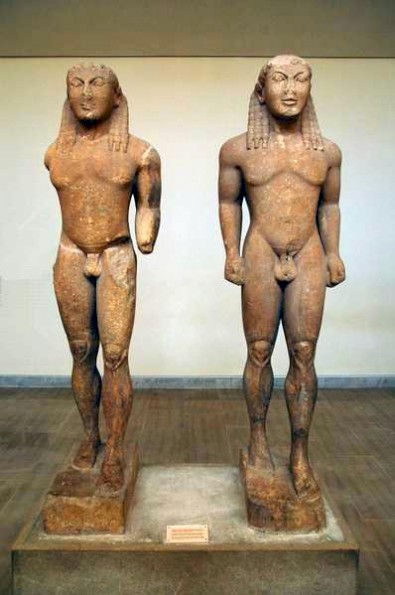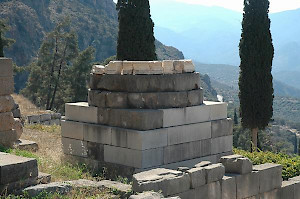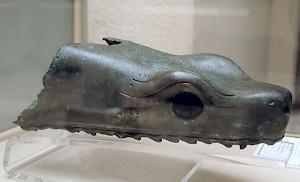Delphi
Q75459Delphi (Greek Δελφοί): oracle, one of the main sanctuaries of ancient Greece.

If a person were called to fix the object in the modern museum of Delphi that best expresses the importance of the ancient sanctuary, he would, without hesitation, name the omphalos, the navel. Long time ago, the supreme god Zeus released two eagles at the edges of the earth, and they met each other at Delphi.
The mytho-scientific experiment was commemorated by the omphalos. This story appears to have been invented to give meaning to an already existing monument, the significance of which was no longer understood. Perhaps, the Delphian omphalos originally was a baitylos, a "house of god", as they were well-known in the ancient Near East.

The Greeks always remembered that Delphi had been an important oracle even in an age when they had not yet venerated Apollo. The oldest name of the site, the Greeks said, was Pytho, after a dragon that Apollo had killed. The priestess, called pythia, sat on a tripod in the vapors of the decomposing cadaver, got into a trance, and uttered strange sounds, which a priest explained to those who had asked for a prophecy. In reality, there is a fault and the prophetess was sitting in a vapor of methane.

Delphi was not the only oracle in the Greek world, but its central position guaranteed that the priesthood was well-informed. Travelers from all directions visited the place and told what they knew. It became one of most important sanctuaries and played a decisive role during the age of colonization. In the sixth century BCE, the oracle was at the height of its influence.
The museum of Delphi has many statues and art objects from this period, like the two young men on the third photo; their names are Cleobis and Biton, and they lived in Argos. According to Herodotus of Halicarnassus, they were the sons of the priestess of Hera, and pulled her chariot when the oxen were still in the field. After this act of pious behavior, their mother asked the goddess for a reward, which was granted: the two tired boys fell asleep and never had to wake up again.note Like most Greek wisdom, the wisdom of Delphi was profoundly pessimistic: happiness was divine, and human happiness only made the immortals jealous.

During the early fifth century, the oracle more or less sided with the Persian invaders of Greece. It is likely that the Persians regarded Apollo as alter ego of their own god Ahuramazda (whose name means "the wise lord"); in any case, they often sacrificed to Apollo. It is likely that the splendid gifts that the Persians had offered to the Delian Apollo convinced the authorities of Delphi to collaborate. When the Greeks had defeated the Persian invader, they constructed their victory monument in front of the temple of Apollo, as if to cock a snook at the god.

On top of the base was a bronze column that consisted of three intertwined serpents, which carried a tripod made of gold. As we will see in an instant, the tripod was sold in the fourth century BCE, and the column was brought to the Hippodrome in Constantinople by the Roman emperor Constantine I the Great in the fourth century CE. This snakehead is now in the Arkeoloji Müzesi of Istanbul.

Although it had backed the wrong horse during the Persian War, the oracle of Delphi remained important. For instance, the Spartans consulted the god before they decided to attack Athens in 431 (the Archidamian War). This is one of the many treasuries in the sacred domain: in this little, temple-shaped house, the Athenians stored the presents they had given to the god. Many cities had similar treasuries.
In the fourth century, king Philip II of Macedonia played the religious card for his own purposes. The Phocians, who lived near Delphi, had been attacked by the Thebans, and had seized the gold and silver from the oracle to hire mercenaries. Stating that he was fighting to vindicate the honor of Apollo, Philip invaded Phocis in 347/346 and subdued Central Greece.

Worse was to come. In 279 BCE, the city was sacked by Celtic warriors.note They moved on to central Anatolia, where they finally settled, but it would appear that parts of the loot were later sent back to the homeland, because Roman soldiers claimed to have found Delphian gold when they captured Toulouse.note The report was already contradicted in Antiquity, though.note
By now, Delphi had lost much of its importance (and wealth). It still existed as a cultural and religious center, but never regained its political power again, although it remained important as a center of "creating Greekness". For example, Roman politicians who wanted to show that they were civilized people, sacrificed in Delphi - if only to gain political support in the Greek world.

When Rome ruled the world, even Delphi's religious significance went into decline; in the Roman period, priest Plutarch of Chaeronea wrote a treatise On the Silence of the Oracles. This statue, found in Delphi, shows a priest of this late period.



